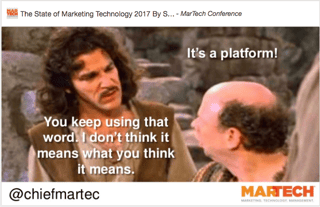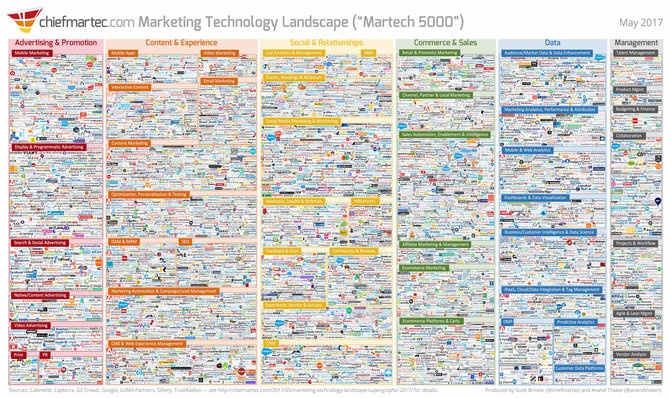The MarTech Marketing Challenge Just Got 40 Percent Harder
May 12, 2017 Samantha McGarry
It’s here! Scott Brinker’s annual opus - his supergraphic of the marketing technology vendor landscape - launched this week as the 2017 MarTech Conference kicked off in San Francisco. Welcoming 2,500+ marketing and technology execs and 100 martech vendors, the conference is surely the who’s who of what’s what in marketing technology.
(Side note: I wish I could be there but alas, here I sit, in Boston, patiently waiting for the October MarTech Conference to come to town.)
So, for those of you who don’t have a magnifying glass strong enough to explore the supergraphic, allow me to synopsize some of its highlights:
- If you thought last year’s graphic was, ahem, busy, then hold onto your horses because this year's graphic features 4,891 unique company logos on one slide - which is surely an unsurpassed feat of design. That’s up 40 percent from last year.
- Of these, 6.9 percent (roughly 300) are enterprises. The rest are private businesses and investor-funded startups.
There’s been a fair amount of debate about how long an industry can sustain this scale of growth; all common-sense signals point to inevitable consolidation. But, interestingly, that’s not (yet?) been the case and, as Scott points out in AdAge, that’s not necessarily a bad thing. For the time being, we can continue to expect a vast mix of platforms and best-of-breeds operating across the blurred lines of the multiplicity of sub-categories in this space. But instead of fighting each other, martech vendors are increasingly embracing the ecosystem through partnerships, integrations and APIs.
Here’s another smart thing Scott (and I have) said: “Remember, marketing is about differentiation.” And it’s kind of tough to differentiate, when you are competing for awareness and mindshare with several thousand others who look and sound like most everyone else.
What’s a martech marketer to do? Here are a few suggestions:
- Appeal to your audience’s emotional drivers. Whether you are selling to a CMO, an IT director or the VP of ecommerce, you need to crack the code of their emotional DNA, Perhaps they have ambitions to climb the ranks and desire more confidence? Are they risk-averse? Afraid of complexity? Your messages needs to resonate and connect at this emotional level - rather than being purely rational and functional.
- Humanize your language. Martech marketers too often suffer from cobbler’s shoes syndrome and get lost in buzzword land. Please, let’s call people people, not users. Do customers really journey? You can read more about my particular issue with this over here.
- Stop talking about your product’s features and functionality. To get attention, you need to first secure interest, and people are most naturally drawn to a perspective or point of view. Once you’ve got their attention, then you can shift the dialog.
- Don’t be afraid to have an opinion. Having a point of view is an important first step - but having a bold, surprising or counter-intuitive one is even better. And it needs to be one that you are passionate about, that resonates with your whole industry and sparks debate.
- Tell stories (and mine your data to inject fresh perspectives). Every good story should have passion, a villain, a hero and a moral. Does yours? And how can data help tell those stories, providing a foundation of credibility and aha’s? Most martech vendors sit on piles of data that, when mined and aggregated through a storytelling lens, can fuel thought leadership ideas and new angles.
- Build relationships. The martech media space is not that enormous. There are a handful of dedicated publications and reporters - so get to know them. Be a resource for them. Understand how they work and the kinds of stories they want to write. It also pays to be on the radar of the key influencers in the space,and there are many more of them than there are reporters.
- Think beyond earned media. Getting media coverage in CMO Today, MarketingLand, Chief Martech or VentureBeat is always a great thing but its shelf life is short. To be sure your great hit isn’t swallowed whole by the 24/7 news cycle, you can use content amplification services and/or paid social ads to precisely target your content to your specific audience.
Scott kindly shared the full slideshow from his State of Marketing Technology 2017 keynote here, but I leave you with the image that made me, literally, LOL.







